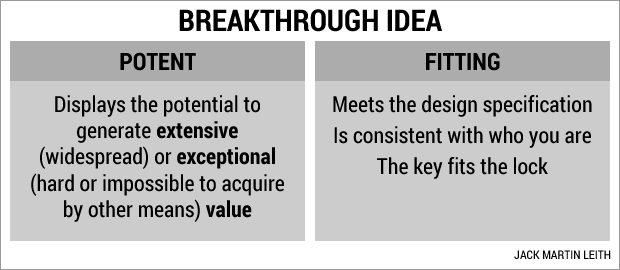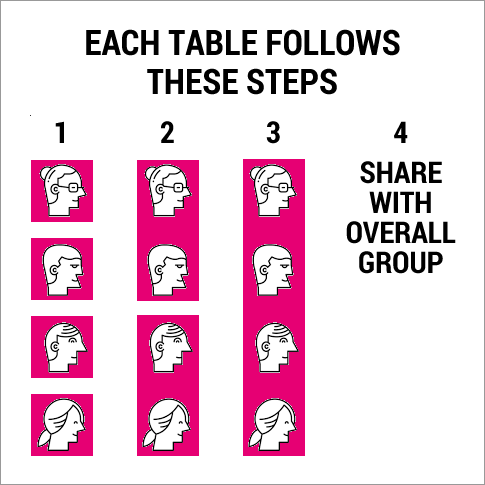If all you need is a run of the mill idea, then brainstorming or some other diverge-converge idea generation method will do the job.
Such methods lean heavily on leftside and synthetic imagination, employing recall, word association, analogy, repurposing, and combinatorial creativity, where existing ideas are combined to form a new one.
Synthetic Imagination Through this faculty, one may arrange old concepts, ideas, or plans into new combinations. This faculty creates nothing. It merely works with the material of experience, education, and observation with which it is fed. It is the faculty used most by the inventor, with the exception of he who draws upon the creative imagination, when he cannot solve his problem through synthetic imagination.
Napoleon Hill, Think and Grow Rich! | Read more about synthetic and creative forms of imagination
Ideas produced by means of synthetic imagination may eventually yield some degree of value, but their value generation potential is likely to be limited.In a brainstorm the default method of finding ideas is by free association. The group having been given the problem or challenge statement, seek ideas in a spontaneous, accidental fashion through internal ‘semantic networks’ of association connecting the challenge to other words, phrases, concepts and experiences they can recall from memory.
Kevin Byron, Creative reflections on brainstorming, London Review of Education, Vol. 10, No. 2, July 2012, 201–213
View more quotes about brainstorming and related matters

When you need a breakthrough idea — one that is potent (displaying the potential to generate extensive or exceptional value) and fitting (the key fits the lock) — the answer is unlikely to reside inside you, waiting to be unearthed. Instead of working outwards from your inner world, you must start in the outside world and work inwards.

This means immersing yourself in the demands and dynamics of the project (either through Readiness work or by other means), activating rightside, the home of creative imagination, and envisioning a possibility for enriching the world, or a particular piece of it, with value, meaning and joy.
The imagined scenario is represented as a vision of realised potential. This is a depiction — an actual picture accompanied by a vivid and compelling synopsis — of how the world will look, sound and feel when the new creation exists in its finished state (even though you do not yet know what form it will take) and its value generation potential is being realised without constraint.Creative imagination Through the faculty of creative imagination, the finite mind of man has direct communication with Infinite Intelligence1. It is the faculty through which ‘hunches’ and ‘inspirations’ are received. It is by this faculty that all basic, or new ideas are handed over to man.
Napoleon Hill, Think and Grow Rich! | Read more about synthetic and creative forms of imagination
1. Napoleon Hill’s Infinite Intelligence is similar in meaning to Edward Matchett’s media (see other terms he used) and Carlos Castaneda’s intent | Read more
Work carried out up to this point should be sufficient for you and your fellow team members to conjure from your imagination a potent idea for a new creation (product, service, enterprise, establishment, theatrical production etc.) with the potential to generate the imagined value, meaning and joy for customers or users and other beneficiaries.
The team’s ideas are captured, discussed and enhanced by means of the Newcreate Idea-to-Concept Method.
The Newcreate Idea-to-Concept Method
Some will recognise this as an elaboration of the 1-2-4-All method that forms part of the Liberating Structures collection. I discovered it in the early 1990s, some 10 years before Liberating Structures came into being, and used it extensively in my work as an innovation practitioner. The originator of the method is unknown.
Output
A single concept is sought: the key that fits the lock.
Requirements
- One facilitator.
- Minimum of four participants, who will have just completed Readiness work, setting the create-the-new project in motion
- Maximum diversity among participant body.
- A suitable venue.
Method
For the purposes of this explainer, we will work on the basis that there are 16 participants and four tables, each accommodating four participants.
If necessary, this can be increased to eight per table with the two groups of four working independently before pooling their outputs. In such cases, a volunteer spokesperson speaks on behalf of both groups, thereby halving the number of report-outs
Each participant is provided with one or more (depending on the detailed process adopted) Idea-to-Concept Worksheets, something like the one appearing below.

Step 1
Working alone and inspired by their earlier Readiness work, participants conceive an idea and record it on an Idea-to-Concept Worksheet similar to the one appearing below. The idea is now on its way to becoming a fleshed out concept.

Download Idea-to-Concept Worksheet (pdf)
Step 2
People form pairs. They take it in turns to explain their concept, with the other person asking questions of clarification. The pairs discuss potential benefits and associated beneficiaries, air any immediately apparent issues (flaws, gaps, obstacles etc.) and suggest ways in which these might be tackled.
The two concepts are merged. If one is considered superior (more potent and more fitting), the other is set aside and retained for Step 6.
Step 3
The two pairs come together. Each pair presents their merged concept to the other pair. The two concepts are then merged, or one is set aside.
Step 4
A volunteer spokesperson presents their table’s concept to the overall group.
Step 5
The facilitator works with the 16 participants to merge the four concepts (one per table) into a single concept that is both potent and fitting.
Step 6
Any concepts set aside at the end of Step 2 are reviewed, ideally in the large group, and reassessed for potency and fit.
Any concept deemed a contender is combined with the one that emerged during Step 5. When such a merger is not possible, the concept taken forward is the one displaying both the greatest value generation potential and the best fit with the design specification.
Voting is not used.
If sufficient time has been allowed, conversations about desirability, feasibility and viability can begin.
Why this method is preferable to brainstorming and its derivatives
- It recognises that an idea is conceived in the imagination of an individual, not in some fanciful group mind.
- Creative imagination and synthetic imagination are integrated.
- All three create-the-new work modes are put into action: creating alone, creating together, and helping others create.
- The Idea-to-Concept Worksheet enables the intangible idea to be made more tangible and makes the idea discussable.
- Ideas are discussed and enhanced, and ways of addressing shortcomings are explored. In this way, the raw idea starts to become a fully formed concept.
- The Max4 Principle (four is the maximum group size for a proper conversation) is honoured.
- The needs of introverts, autistic people, other neurodivergent members of society and the socially anxious are accommodated.
- A single concept emerges: one that is potent and that fits the lock.
Our species is the only creative species, and it has only one creative instrument, the individual mind and spirit of man. Nothing was ever created by two men. […] Once the miracle of creation has taken place, the group can build and extend it, but the group never invents anything. The preciousness lies in the lonely mind of a man.
John Steinbeck, cited by Roger S Bacon in The Myth of the Myth of the Lone Genius
Continue reading
Brainstorming
Quotes about brainstorming and related matters
Why brainstorming does not form part of Newcreate work
Now-to-New work: create alone, create together, help others create
How does Newcreate compare with design thinking?
How Newcreators use mind, body and spirit to create the new and enrich the world
How to put Newcreate into practice
The Max4 Principle: The maximum group size for a proper conversation is four
Newcreate and other Now-to-New methods
The two forms of imagination: creative and synthetic
Index to entire site (60+ pages)
Search the site
Not case sensitive. Do not to hit return.